
|
Sale 22
Manuscript and Collectibles Auction
| The Stuart Goldman Collection |
| |
| |
| Lot |
Photo |
Description |
Realized |
Lot 1 |
|
1686 Deed For Land In Philadelphia. Manuscript Document signed with the mark of Elizabeth Shorter, Philadelphia, July 12, 1786, only 3½ years after Philadelphia was established as the capital of Pennsylvania, 7¾ x 7¼ in., with attached docket leaf. In part: "I Eliz: Shorter widdo: of Philadelphia in ye province of Pennsylvania for the Consideration of one hundred pounds Sterling unto Christopher Libthorpe…my housing in the front street of Delawar with my lott and dwelling…." Witnessed by two men. Boldly written. Light toning and soiling, else Fine. Between 1643 and 1681, Swedes and Dutch settled in the area, as well as Finns and English. In 1681, William Penn received the title to Pennsylvania from Charles II, and in October 1862, the city of Philadelphia was established. It became the seat of goverrnment and capital of Pennsylvania in March 1683.
Estimated Value $1,000 - 1,500.
View details
| Realized
$1,001 |
Lot 2 |
|
Two 17th Century Massachusetts Military Documents. Two manuscript documents, one from May 24, 1664, no city, and one from April 8, 1682, Taunton (Mass.), both reflecting the state of alert in which the colony remained as a result of the Native American wars that were ongoing until the 1680s. The earlier document, 13 x 8 in., fixes fines for those who do not follow orders or who lack the proper arms and ammunition; small areas of paper loss at folds and in right margin; a 4¼ x 3 in. area of paper loss at botton center seems to only affect one line of text. Fair condition. The second document, 16 x 12 in., is headed "The Military Company of Taunton are here Divided into four Squadrons in order to their Bringing their Armes to meeting…according to Court order…." The names of the men in each of the four squadrons are listed in four columns. The Court order is set out below the columns: "The Court order is that every souldier bring his armes fixed to meeting when it is his turn with six charges of powder & shot…." Those who neglect or refuse to perform their duty will be fined and "if any stay from meeting because they will not bring their Armes to meeting such to be summoned to Court. Therefore fail not of your duty; & Expect noe further warning." Archivally backed; overall toning. Very good condition. Researching the names on this document could be quite a learning experience in early Massachusetts history. (2 items).
Estimated Value $1,500 - 2,000.
View details
| Realized
$3,220 |
Lot 3 |
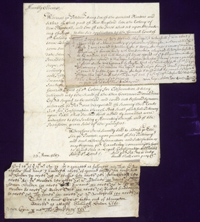 |
Collection of 17th Century Documents. Twenty-three manuscript documents, including a petition to the Royal Governor, deeds, receipts, a summons, and other documents. All are New England related. Sizes range from 2 x 7 inches to folio. A 1676 document is addressed to Capt. John Hull, possibly the John Hull who established a mint in Boston in 1652. A 1693 document records court presentments, including "…Doritha Pain…for beating and abusing Nicolas Evans…" and "..Sarah Willcock…for committing of fornication…" Several documents pertain to a James Leonard of Taunton, including a 1687 petition to Governor Edmond Andros which reads, in part: "Whereas ye Petitioner being One of the auncient Planters and Setlers of that part of New England late the Colony of New-Plimouth, and One of the first that set upon the making of Iron…made his application…upwards of Twenty years since for a Grant of Land…and was encouraged…to Looke out for some suitable place…yo[ur] Pet[ioner] haveing Acquaintance and Friendship with Phillip, then Chief Sachem of Mount-hope, obteined a Deed of him for a small neck of Land comonly called Quashatuckik…Lying upon Mattapoyset River near to Swansey…." Government bureaucrats lost the deed, but Leonard states that he has plenty of witnesses that the deed existed and would like "a Legall Confirmation and Patent for ye sd. Land." Other documents refer to Leonard as Captain Leonard, and, in another, Leonard writes, "…I would request you to pay to this Indian Samnosuña eighteen shillings in goods…."Interesting documents, worth research. Normal age wear. Good to Fine.
Estimated Value $2,000 - 2,500.
View details and enlarged photo
| Realized
$7,763 |
Lot 4 |
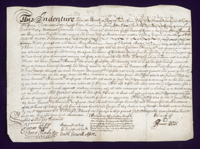 |
Sewall, Samuel & Bradstreet, Simon. Manuscript Document Signed ("S: Bradstreet") as Governor and ("Sam Sewall Assist."), June 11, 1684, Boston. One page oblong folio. An indenture by which the selectmen of Boston place Adam Martin, "sonne of Elizabeth Martin decd (Going apooze Child of the sd Towne) as an apprentice to…James Wood…" for nineteen years. An attractive document, missing tips of lower corners and faint show-through from docket; otherwise, in fine condition, with bold signatures.
Simon Bradstreet was governor of the Massachusetts Bay Colony May 28, 1679-May 20, 1686 and June 7, 1689-May 16, 1692. He was the son-in-law of Thomas Dudley, thrice Massachusetts Bay Colony governor (1634, 1640, and 1650); his wife, Anne Dudley Bradstreet, was the first female author in America. Samuel Sewall is best known for being one of the judges who condemned nineteen innocent men and women to be hanged as witches during the Salem witchcraft trials of 1692. In 1696, Sewall apologized for his role in the trials (the only judge to do so), and thereafter set aside a day each year in which he fasted and prayed for forgiveness. In 1700, Sewall published The Selling of Joseph, considered the first anti-slavery piece published in the colonies. It brought him further notoriety. Documents signed by Sewall are rare.
Estimated Value $1,500 - 2,000.
View details and enlarged photo
| Realized
$3,220 |
Lot 5 |
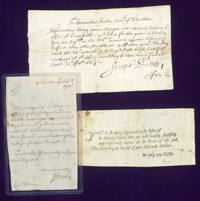 |
Dudley, Joseph (1647-1720) President of New England; Royal Governor of Massachusetts.
Two Manuscript Documents Signed, one as Governor of Massachusetts ("J Dudley") and the other as a magistrate. The first, datelined February 19, 1706, Boston, one page, 6 x 3¾ is addressed to Col. Thomas. Dudley writes that this letter accompanies "Mr. King an officer of the Galley, who I have sent to review your men; which I Expect are all good men and in readiness. And that you will send them forward according to my Order sent you for their draught. Treat the Officer civilly and give him dispatch." The second letter, February 21, 1683/4, Boston, one page, 4½ x 7½ inches, is addressed to Cornelius Fisher, senior, of Wrentham, informing him that he has been chosen as constable for the town and that he "should appeare before myselfe or some other Magistrate at Boston…to take ye Oath…" A printed, period oath is included. Normal age wear. Very Good to Fine. Sanders lists letters signed by Dudley at $895 each. (3 items)
Dudley was the son of Massachusetts Bay Colony Governor Thomas Dudley. He was a member of the Massachusetts General Court (1673-1676), a member of the Upper House in the Massachusetts Bay legislature (1676-1683, 1684), and was Commander of the United Colonies of New England (1677-1681). He served as Chief Justice of Colonial Superior Court (1687-1689), and after the Glorious Revolution of 1688, was appointed chief of the Council of New York (served 1690-1692). From 1702-1715, he was Royal Governor for Massachusetts under Queen Anne.
Estimated Value $1,000 - 1,500.
View details and enlarged photo
| Realized
$1,265 |
Lot 6 |
|
Collection of 17th Century Indentures. Twenty-seven early Massachusetts Bay Colony documents, twenty-five dated from 1668-1699 and two dated 1743 and 1770. The documents include large, formal vellum and paper documents, many with wax seals extant, and smaller, informal legal documents. There is general toning and soiling; numerous repairs; some with areas of paper loss. Condition ranges from poor to very good. It would be worthwhile researching the names on the documents to see if they were of significance in the history of the colony. Sold "as is."
Estimated Value $1,500 - 2,000.
View details
| Realized
$6,325 |
Lot 7 |
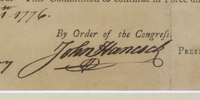 |
Hancock, John (1737-93) First signer of the Declaration of Independence; served in Continental Congress, elected President 1775-77; Governor of Massachusetts 1780-80, 1787-93.
Partly-printed Document Signed as President of the Continental Congress, January 1, 1776 (Philadelphia). One page oblong folio, on laid paper, matted to 17 x 19 inches. Appointing Hugh Maxwell Esqr. "Captain of a Company in the 7th Regiment of Foot Commanded by Colo. William Prescot in the Army of the United Colonies, raised for the Defence of American Liberty, and for repelling every hostile Invasion thereof…." Countersigned by Charles Thomson as Secretary of the Continental Congress. Small areas of paper loss along folds in upper half of document, not affecting Hancock's very bold signature.
William Prescott and Israel Putnam were in command of fortifying Bunker Hill and Breed's Hill on June 16, 1775 and led the battle against the British the next day. Hugh Maxwell was lieutenant of a company of minute men who marched to Cambridge and joined Prescott's regiment. He was wounded in the right shoulder during the battle. This is Maxwell's promotion to captain in Prescott's regiment, signed in 1776 by John Hancock as President of the Continental Congress. In Revolutionary War material, it doesn't get much better than this!
Estimated Value $6,000 - 8,000.
View details and enlarged photos
| Realized
$7,763 |
Lot 8 |
 |
Hancock, John. Partly-printed Document Signed as Governor of Massachusetts, October 30, 1782, Boston. One page oblong folio, on laid paper. Appointing "Hugh Maxwell Esqr. to be Lieutenant Colonel in the Eighth Massachusetts Regiment of Foot, one of the Battalions raised by this Commonwealth, to serve in the Continental Army, whereof Michael Jackson Esq; is Colonel…." Countersigned by John Avery as Secretary of the Commonwealth of Massachusetts. Light overall toning, some darker foxing at top of document, and a couple of small pinholes at folds. John Hancock's signature is especially large and beautiful. An excellent document for framing and display.
Estimated Value $4,500 - 6,000.
View details and enlarged photo
| Realized
$3,910 |
Lot 9 |
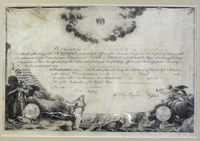 |
Washington, George (1732-99) 1st President of the United States. Partly-printed Document Signed ("Go: Washington" as President of the Society of the Cincinnati, Philadelphia, May 5, 1784. One page, oblong elephant folio, vellum, matted to 15 x 21½ inches. Being the membership certificate of Lieutenant Colonel Hugh Maxwell in the Society of the Cincinnati, "instituted by the Officers of the American Army at the Period of its Dissolution, as well to commemorate the great Event which gave Independence to North America, as for the laudable Purpose of inculcating the Duty of laying down in Peace Arms assumed for public Defence, and of uniting in Acts of brotherly Affection, and Bonds of perpetual Friendship the Members constituting the same." Countersigned by Henry Knox ("H Knox") as Secretary of the Society. Small areas of age toning. Patriotic engravings cover the lower portion of the certificate, and the eagle badge of the Society is at the top. Both signatures are of medium boldness. A very desirable document in Fine condition.
Hugh Maxwell was born in Ireland in 1788, the same year his family emigrated to New England and settled on a farm in Bedford. Hugh became a surveyor and a farmer. He served in five campaigns during the French and Indian War. In 1773 he settled in Charlemont, now Heath, Massachusetts. Early in 1775, he was appointed lieutenant of a company of minute-men, with whom he marched to Cambridge on hearing of the Lexington battle, and joined Prescott's regiment. He was commissioned captain on May 10, 1775. At Bunker Hill, a ball passed through his right shoulder. He served in Prescott's regiment near New York, and afterward in Bailey's 2nd regiment, of which he was commissioned major July 7, 1777. He was commissioned lieutenant colonel of M. Jackson's 8th regiment August 1, 1782. He was present at the siege of Boston, battles of Trenton, Princeton, Saratoga, and Monmouth, and in the successful attack in January 1781, on De Lancey's Loyalists at Morrisania. He was town clerk of Heath in 1791-99; Justice of the Peace in Hampshire Co. 1785-99; and died on the return voyage from the West Indies October 14, 1799. He married Bridget Monroe of Lexington in 1759 and had seven children.
Estimated Value $10,000 - 15,000.
View details and enlarged photos
| Realized
$14,950 |
Lot 10 |
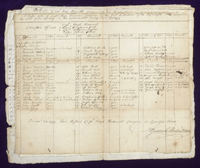 |
Four Valley Forge Muster Rolls. Four muster rolls for Captain Hugh Maxwell's Company for the months of December 1777, and January through March 1778, in camp at Valley Forge. One page each, large oblong folio. The first roll is headed "A Muster Role of Captn. Hugh Maxwells Company in the first Battallion of the Massachusetts State Commanded by Colo. John Bailey in the Continentall Army Decem. 24 1777." The January 1778 roll has the same information, except that it reads, "in the service of the United States of America," instead of "in the Continentall Army." February and March 1778 specify that they are for "…Capt. Hugh Maxwells Company of the first Regiment of foot in the service of the United States…."
The muster rolls list the commissioned officers: Capt. Hugh Maxwell, 1st Lt. Benjamin Ball, 2nd Lt. William Taylor, and Ensign Josua Peirce. Benjamin Ball was discharged in February and does not appear on the March roll. John Bailey, and Hugh Maxwell signed all four rolls; additionally, William Taylor signed the Dec. 1777 and Jan. 1778 rolls. Each muster roll lists the rank of each man, whether he enlisted for the duration of the war or for three years, and remarks, such as whether he was sick, on furlough, on command, had died, etc.
The February and March rolls actually name "Valley Forge"; the other two do not, but Maxwell's company entered Valley Forge in December 1777 and left in June 1778. All four documents have some age toning and wear, but all four are boldly written and of special historical significance because of their association with Valley Forge. Overall Fine.
Valley Forge, more than any other place associated with the American Revolution, has come to epitomize the suffering and sacrifice, as well as the perseverance and fortitude, of the American Army led by George Washington. Almost one in ten men died during the seven months they were encamped at Valley Forge, most of them from disease. Valley Forge also represents the metamorphosis of the American army from ragged, undisciplined troops into a unified fighting force.
Estimated Value $6,000 - 8,000.
View details and enlarged photo
| Realized
$13,800 |
Lot 11 |
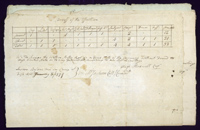 |
Four 1778 Muster Rolls. Muster rolls for Captain Hugh Maxwell's Company in the First Battalion From Massachusetts, under the command of Col. John Bailey, for the months of August, September, October, and December 1778. The rolls list the ranks of the soldiers, the date they were appointed, their term of enlistment, and any remarks. The commissioned officers listed on all four rolls are Hugh Maxwell, Capt.; William Taylor, Lieut., and Joshua Peirce, Ensign. All were commissioned on January 1, 1777.
The August roll is datelined White Plains and is signed on the verso by Bailey, Maxwell, and Peirce. The Remarks column notes one soldier as "Sick Valy Forge," and others "Sick French Creek," "wounded at Trenton," etc. The September roll is datelined Danbury and is signed on the verso by Bailey, Maxwell, and Peirce. Remarks include "Sick Fish-kill," "on command Light Infantry," etc. The October roll is datelined Hartford and is signed on the verso by Maxwell and by Michael Jackson as Colonel Commanding. The December muster roll is datelined Fish-kill and signed on the verso by Maxwell and Jackson. All have normal toning and age wear, otherwise Fine. (4 items).
Estimated Value $5,000 - 7,500.
View details and enlarged photo
| Realized
$4,370 |
Lot 12 |
 |
Three War-Date Documents For The 2nd Massachusetts (1) Manuscript Document: "A Roll of the Men's Names in Capt. Hugh Maxwell's Compy 2d Massa.ts Regt Commanded by Col. Jno. Bailey," and docketed "..For the depreciation of the Money 1777 1778 & 1779," 16½ x 13¼ in. Columns include date of enlistment, names, rank, pay per month, town and county of origin, term of enlistment, and remarks; the latter notes death from battle or other reasons--desertions, appointments, promotions, etc. Heavy toning at top and botton do not affect legibilty.
(2) Manuscript Document: "List of the Commissioned, and Staff Officers, in the 2d Massachusetts regiment commanded by Lt. Colo Comdt Sprout." Columns show the date the men were commissioned or appointed, their name, rank, and remarks. Major Hugh Maxwell is noted as being "On Command at Stanford." Light toning, else Fine.
(3) Manuscript pay document, ragged at top edge, with paper loss at top of three columns, 7½ x 9 in. The first column is headed, "1777 Men Inlisted for 3 years or during the war"; Hugh Maxwell's name is listed with "for Gil.t Henry" after it, perhaps indicating that Maxwell accepted Henry's pay. The second column has £14: 0 : 0 after each name. The third and fourth columns seem to be "for three years" and "during the war." At right is a column of 18 names, headed by Col. Bailey. Seven other names are listed on verso, including Hugh Maxwell. Tape remnants on verso of lower corners. Still an interesting Revolutionary War document. (3 items).
Estimated Value $2,000 - 3,000.
View details and enlarged photo
| Realized
$1,323 |
Lot 13 |
|
Four Revolutionary War Documents Belonging to Captain Hugh Maxwell (1) Manuscript Document datelined Kings Bridge, October 1, 1776, one page folio. With the signatures or marks of the 52 men in Capt. Hugh Maxwell's company, acknowledging receipt of payment: "Recd. of Capt. Hugh Maxwell Each of us the full of our pay as Comisiond Non Comisiond Officers and privates in his company in Collo. Prescotts Regt for the Months of July and August Last 1776." Toning and and a few ink stains, else Fine.
(2) Manuscript Document datelined Camp, October 19, 1776, one page folio. With the signatures or marks of 43 men in Capt. Hugh Maxwell's company, acknowledging "Recd. of Hugh Maxwell Each of us Fourteen Shilling and ten pence in full for our Back Allowance of Beer Beeff Sauce &c till the Sixteenth of September Last." Normal toning and a couple of small fold repairs on verso. Written on laid paper with a beautiful "Pro Patria" watermark."
(3) Manuscript Document docketed, "Cap. Maxwell's Co., a/c Jan. 7, 1777," 13¼ x 16½ in. opened. On one side are the names of the men in the company, their town of origin, date of enlistment, duration of enlistment (3 years or "during war"), seven columns of figures, and a column listing whether the men were killed, dead or missing, or deserted. On the verso is a list of expenses incurred by Maxwell and other officers "on the Recruiting Service," as well as bounties for 56 men and expenses for enlisting them. Expenses were paid by either Col. Bailey, who commanded the regiment, or the quartermaster, Robert Bradfort. Some dark toning at center fold; ink stains in blank lower area affect nothing.
(4) Manuscript Document Signed by Hugh Maxwell at Lt. Col., no place, February 1, 1783, 5½ x 8 in., acknowledging receipt of Quartermaster General Timothy Pickering for D. Wolfe, "one hundred and five dollars and twenty one ninetieths in full for forage rations due from the first day of Jany 1782 to this day…." Fine.
Estimated Value $4,000 - 6,000.
View details
| Realized
$2,875 |
Lot 14 |
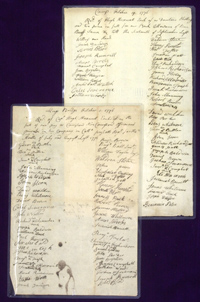 |
Expenses For Shay's Rebellion. Manuscript Document Signed by Hugh Maxwell and Asaph White, selectmen of the town of Heath, Massachusetts, April 14, 1787, requesting reimbursement for provisions they furnished eleven men from the town who marched to Springfield and were with General William Sheperd when he defended the Federal Arsenal against Daniel Shay and 2,000 farmers. "In Obedience to orders Received from Major General [William] Shepard to furnish the men who should March from the Town of Heath to Springfield in January last with provision until the Commissary should counder order, we the Selectmen of the Town did furnish provision for Eleven Men who marched; from the fifteenth day of January to the twenty sixth…we have credit on the Roll for only Six days provision, leaving due to us six days Rations…." Below the computation of the amount due is, "Heath Aprill 14, 1787. to the Honorable the Committe for Settling the amounts of the Expense incurred by the Rebellion," signed by Maxwell and White. Below this statement is a signed statement by the captain of the men, certifying that they did serve in his company and "they did not draw provision from the public store during the six days Referred to…." Other official notations follow. The one-page folio document is lightly toned and soiled, else Fine.
Shay's Rebellion was an armed uprising that lasted for six months, from August 29, 1786 to February 3, 1787. It was caused by an economic depression that severely affected the farmers of Western Massachusetts. When their petitions to the government for paper currency, lower taxes, and judicial reform went unanswered, an armed group of farmers, led by Daniel Shays, a veteran of the Revolution and a farmer from Pelham, occupied courts in several towns, hoping to prevent further trials and imprisonment for debtors. Governor Bowdoin assembled 4,400 militiamen under General Benjamin Lincoln to protect the Commonwealth. When the Federal arsenal was assaulted on January 25, 1787, General William Shepard defended the arsenal with 1,200 local militiamen, among whom were the eleven men from the town of Heath. General Lincoln arrived in Springfield the next day and chased Shay's army, taking them by surprise on February 3rd in Petersham and ending the rebellion. Of the fourteen leaders, including Shay, who were condemned to death for treason, all but two were pardoned. As Justice of the Peace for Hampshire County, Hugh Maxwell administered the Oath of Allegiance to those insurgents who gave up their arms. Shay's Rebellion is considered one of the leading causes in the formation of the United States Constitution.
Estimated Value $1,500 - 2,000.
View details and enlarged photo
| Realized
$4,888 |
Lot 15 |
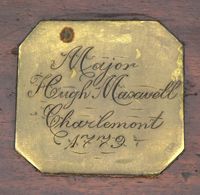 |
c. 1770, Cased Set of Wogdon Flintlock Dueling Pistols Belonging to Major Hugh Maxwell. Matched, custom-made set housed in a 9 x 22 x 2½ inch English walnut case, lined with green Irish baize, with brass plaque inscribed, "Major Hugh Maxwell / Charlemont / 1779." The silver-mounted pistols have ten-inch octagonal, steel barrels, engraved "Wogdon London"; the silver lock plates are engraved "Wogdon." Various parts of the pistol's hardware have attractive ornamental engravings, mostly as rosettes. One of the ramrods is probably a replacement and one pistol has minor splitting to stock. Accessories include a bullet mold, a gunpowder flask with storage compartment for bullets, a cleaning rod, eight bullets and eight flints. In full working order. Overall Very Fine condition. Robert Wogdon's dueling pistols were considered the crème de la crème because of their accuracy. After Wogdon's death, it was discovered that he had bent his pistol barrels slightly to make the bore true. The pistols were deaccessioned from the Francis T. Maxwell Memorial Library.
Hugh Maxwell was an American surveyor and farmer from Charlemont (now Heath), Massachusetts who fought in five campaigns during the French and Indian War. In early 1775, he was appointed lieutenant of a company of minute men, with whom he marched to Cambridge, joined Col. William Prescott's regiment, fought and was wounded at the battle of Bunker Hill. He was commissioned major July 7, 1777 and lieutenant colonel August 1, 1782. He was present at the siege of Boston, battles of Trenton, Princeton, Saratoga, and Monmouth, and in the attack on De Lancey's Loyalists at Morrisania.
Estimated Value $15,000 - 25,000.
View details and enlarged photos
| Realized
$25,300 |
Lot 16 |
 |
c. 1770s, Flintlock Pistol Belonging To Hugh Maxwell. English side-by-side, box-lock pistol with 5½ in. barrels. Silver inlaid handle with ornale scroll and canthus motifs. Upper handle has inset medal with initials "H M". Finely chased silver butt with full hallmarks, and design of rampant lion behind wall, with foliate borders. Side lock is engraved "London"; maker's name not discernible; evidence of proofing marks. Operable but lacking half-cock safety and spring for selector cover. Overall Fine or better condition. Notable for the contemporary artwork. This pistol belonged to Revolutionary War offier Hugh Maxwell. The quality of this pistol and other weapons he bore indicate that he and his family had achieved some degree of affluence.
Estimated Value $4,000 - 6,000.
View details and enlarged photo
| Realized
$4,370 |
Lot 17 |
 |
Sword. Three-edged blade of triangular form with deep blood channel on one side. The bifurcated guard of brass, along with rest of handle in brass and wood. Wood with ornate, wire-wrapped ends. The blade with dark brown patina and occasional pitting. The wood handle is smooth from use. Overall an attractive example of the kind of swords that the Americans acquired for their troops from the French and Dutch during the Revolutionary War. Overall Fine condition. Purported to have belonged to Revolutionary War officer Hugh Maxwell.
Estimated Value $600 - 800.
View details and enlarged photo
| Realized
$633 |
Lot 18 |
 |
F.C. Harlem, 1781. Major Hugh Maxwell of Charlemont, Massachusetts. Painted full-length silhouette on horseback of Revolutionary War officer Major Hugh Maxwell. The silhouette shows Maxwell in full uniform on his prancing horse. Beautifully executed on a 12¼ x 9¼ in. sheet of paper which is signed by the artist in the lower right corner. Extremely rare.
Estimated Value $1,000 - 2,000.
View details and enlarged photo
| Realized
$2,185 |
Lot 19 |
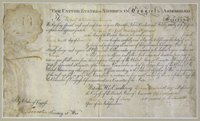 |
Boudinot, Elias (1740-1821) Member of Continental Congress, president (1782-1783); U.S. House of Representatives (1789-1795); Director of U.S. Mint (1795-1805).
Partly-printed Document Signed as President of the Continental Congress, June 3, 1783, Philadelphia. One page oblong folio, vellum, matted to 17 x 19 inches. Boudinot appoints "Robert Wilson Gentlemen…Ensign in the first New York Regiment in the Army of the United States, to take rank as such from the twenty ninth day of June 1781…." Countersigned by Benjamin Lincoln ("B Lincoln") as Secretary of War. Boudinot signed at upper left under the "United States of America War Office" seal. Some wear and discoloration at edges of vellum. Overall Very Good. A historic document.
Robert Wilson was born in New York City (date unknown). His father died before the Revolution and his widowed mother moved with her six children to Albany, N.Y. Robert enlisted in the Revolution at about the age of 12 and served as fifer with the New York troops in the company of his mother's brother, Captain James Gregg. On June 9, 1781, he was commissioned ensign in the First New York Regiment, and served until the close of the Revolution. During Cornwallis' surrender at Yorktown, when the British officers did not want to surrender their standards to a noncommissioned officer, Colonel Alexander Hamilton appointed Wilson Officer of the Day to conduct the ceremony of receiving the British flags. He received the colors of twenty-eight British regiments from twenty-eight British captains and handed them to twenty-eight American sergeants. (See in this same collection the sword presented by Alexander Hamilton to Robert Wilson December 25, 1781). Wilson later became the second postmaster in Manlius, New York.
Estimated Value $3,000 - 4,000.
View details and enlarged photo
| Realized
$5,175 |
Lot 20 |
 |
Washington, George. Partly-printed Document Signed ("Go: Washington") as President of the Society of the Cincinnati, Mount Verson, December 4, 1785. One page, oblong elephant folio, vellum, matted to 15 x 21½ inches. Being the membership certificate of Robert Wilson "Rank Red in ye late War" in the Society of the Cincinnati. Countersigned by Henry Knox ("H Knox") as Secretary of the Society. Even age toning and slight waviness to vellum, with browning in margins. Unusually attractive for a Society of the Cincinnati membership; these documents are not common, and those that remain are often in poor condition. Both Washington's and Knox' signatures are nice and strong. Overall Fine.
Estimated Value $10,000 - 15,000.
View details and enlarged photos
| Realized
$14,950 |
Lot 21 |
 |
Sword Presented On By Alexander Hamilton To Ensign Robert Wilson. Dress sword, 34 inches long, engraved on under side of guard, "Presented to / Ensign Robert Wilson / From / Lieu't Col. Alexander Hamilton / Dec. 25th 1781." Hilt originally wound with fine silver wire; the guard, pommel, bow and trimmings are all silver, and the scabbard is of black leather. The blade seems to be of Italian or Spanish workmanship, of the rapier pattern. The sword was presented by Hamilton to Ensign Wilson, the youngest commissioned officer in the American army, as a memento of the part he played in the surrender of Cornwallis' forces at Yorktown. This is truly a unique and historic sword.
Included with the sword is an original catalogue published by Emmor K. Adams of Cranford, New Jersey, in 1918, documenting his collection of "Arms, Weapons And Relics of American Wars, &c. Especially the Revolutionary War." This sword is the second item described, No. 102. Adams writes how he came into possession of the sword: "…Thomas Crawford of N.Y. City, came into possession of this sword through James Gregg Wilson, son of Ensign Robert Wilson, who was one of the proprietors of a newspaper called Brother Johnathan, published in N.Y. John Crawford, son of Thomas, sold it in 1861 to William M. Taylor, a Printer, of No. 32 Liberty Street, New York City, from whom it was purchased and added to this collection." Addition information, dated June 4, 1934, notes that after Adams' death, his entire collection was sold to Robert Fridenberg of New York City. The inscription was probably added by a later owner.
On October 19, 1781, Lord Cornwallis surrendered with his entire force, military and naval, to the allied forces of America and France. The Army, with all of its artillery, stores, military chest, etc., was surrendered to General Washington; the Navy, with its appointments, was surrendered to Admiral de Grasse. The delivery of the colors is recounted in Benson J. Lossing's The Pictorial Field-Book Of The Revolution: "…For this purpose, twenty-eight British captains, each bearing a flag in a case, were drawn up in line. Opposite to them, at a distance of six paces, twenty-eight American sergeants were placed in line to receive the colors. Ensign Wilson of Clinton's brigade, the youngest commissioned officer in the army (being then only eighteen years of age), was appointed by Colonel Hamilton, the officer of the day, to conduct this interesting ceremony. When Wilson gave the order for the British captains to advance two paces, to deliver up their colors, and the American sergeants to advance two paces to receive them, the former hesitated, and gave as a reason that they were unwilling to surrender their flags to noncommissioned officers. Hamilton, who was at a distance, observed this hesitation, and rode up to inquire the cause. On being informed, he willingly spared the feelings of the British captains, and ordered Ensign Wilson to receive them himself, and hand them to the American sergeants…"
Estimated Value $10,000 - 20,000.
View details and enlarged photo
| Unsold |
Lot 22 |
 |
Pewter Tea Cannister and Creamer Belonging to Robert Wilson. The canister is a narrow oval box with a hinged lid and nob handle, with lock but lacking key. Exterior with ornate engraving on walls and lid, the walls with floral borders and swags and oval cartouche on both sides with the initials "R W." The lid has similar pendant border and central starburst emanating from the handle. The hinge with, apparently, several repairs, one old and perhaps contemporary with the box, along with some more recent work. The lid has an added inscription, old, perhaps within a generation or two of the war: "Used in Camp in the War of the Revolution, 1781." Height: 4½ in.; Width: 5½ in. Condition better than Fine.
Along with the canister is a contemporary creamer--footed, with deep-bowl and arching handle. Border and shield cartouche engraved in same manner seen on canister, but by a different hand. The shield bears the initials, "R A W"; some dark spots in the patina. Height: 5 in. Overall Very Fine condition.
Robert Wilson was the youngest commissioned officer in the Revolutionary War army. He was 18 at the time of the Battle of Yorktown.
Estimated Value $3,000 - 4,000.
View details and enlarged photo
| Realized
$3,680 |
Lot 23 |
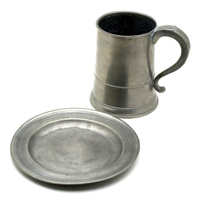 |
Joseph Danforth Pewter Quart Mug. Tankard of classic 18th century shape, lidless, with scroll handle. Simple ornament of ring moldings. Touchpiece stamped in middle of inside base: a rampant lion on short ground line with flanking "J D"; on exterior base, light, old griffiti; one discernible name--"Prudence Goodrich", atop an earlier griffito, "Goodrich." Vessel is wider at the bottom, making it spill resistant. Aside from the usual handling marks over the years, the vessel is well preserved. Joseph Danforth was one of six sons of Connecticut pewtersmith Thomas Danforth, who pioneered American pewter-making between 1755-82. Joseph worked from 1779-1788. Included is a newspaper article showing that the consignor paid $2860 for this mug in 1999.
Estimated Value $2,500 - 3,000.
View details and enlarged photo
| Realized
$3,450 |
Lot 24 |
|
Revolutionary War-Era Pewter Plate By Thomas Danforth. Eight-inch plate from Connecticut pewtersmith Thomas Danforth II. It looks to have been cast and hammered, rather than spun. It has a typical shallow form, with a ridge lip. Two touchmarks are on the base, both consisting of a lion in a gateway composed of two columns topped by fleur de lys, under a curved banner inscribed "Thomas"; at the bottom, "Danforth" has worn away. The pseudo-hallmarks touch of Thomas Danforth II are below, the "T D" being very clear; the other three being successively more worn. With the usual scuffmarks of decades of use, but Overall Fine condition. American pewter by Thomas Danforth is quite rare. Danforth pioneered pewter-making in the United States between 1755 and 1782 and founded a family of famous pewterers.
Estimated Value $1,500 - 2,500.
View details
| Unsold |
Lot 25 |
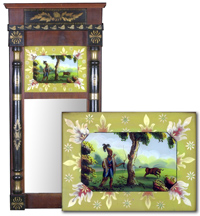 |
c. 1850 Mirror With Reverse Painting On Glass Of Southeastern Indian Hunting Scene. Wooden frame 38 in. high x 18¼ in. across, holding a 17½ x 11½ in. mirror, and featuring an 11½ x 8½ in. reverse painting on glass above the mirror. The colorful painting has a decorative border surrounding a 5 x 8 in. hunting scene, portraying an Indian holding a bow, an arrow in one hand and a quiver of arrows on his back, advancing toward a buffalo. The Indian has on warm-weather clothing and short moccasins; he wears a turban decorated with bird plumes. The colors are vibrant--green, yellow, brown, blue,and a touch of red. A beautiful, decorative piece.
The mirror is a columnar frame in the Neo Classic style. The frame is comprised of mahogany boards or veneer, and the architectural motifs are painted in gilt and black daub stencil work. Motifs are typical classical items of foliage and ewers. The painted border to the reverse painting shows similar stencil work in the foliate border. Some minor splits to the veneer, but the condition of the painting is exceptional. The mirror was possibly replaced, but the frame and reverse painting are original. This work was obviously well cared for by its owner(s) and was a highly-valued piece of furniture. It will serve as the focal point in a period room.
Estimated Value $3,000 - 5,000.
View details and enlarged photo
| Realized
$2,070 |
Lot 26 |
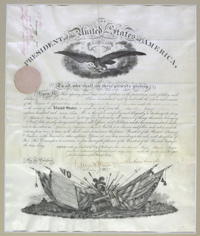 |
Lincoln, Abraham (1809-65) 16th President of the United States. Partly-printed Document Signed as President, March 13, 1863, Washington. One page elephant folio, vellum. Appointing Robert P. Wilson "Assistant Adjutant General of Volunteers with the rank of Captain." Countersigned by Edwin M. Stanton as Secretary of War and docketed in upper left corner by Adjutant General Lorenzo Thomas ("L. Thomas"). A very attractive document with the usual military engravings and intact pale pink seal. The document is matted with a signed carte de visite of Robert P. Wilson ("Yours truly, R.W. Wilson") and a carte de visite of Lincoln in three-quarter pose; backprints of neither card can be seen. Overall size is 28 x 21 inches. Very Fine.
Robert P. Wilson was the grandson of Revolutionary War soldier Robert Wilson, who accepted the British standards at Yorktown. Robert P. enlisted immediately after Fort Sumter, serving with the 16th New York Infantry as adjutant in the Battle of Bull Run, and afterward as Assistant Adjutant General in General Bartlett's brigade. While storming a fort on the Rappahannock in November 1863, he was disabled by a bullet that shattered his right arm. In February 1864, he received an honorable discharge for permanent disability.
Estimated Value $5,000 - 7,500.
View details and enlarged photos
| Realized
$6,038 |
Lot 27 |
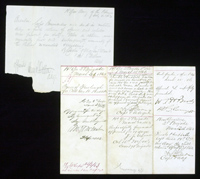 |
Collection of Civil War-Date Letters and Documents. A collection of 28 letters and documents written by, to, or about Robert P. Wilson, who served with the 16th New York Infantry and the 121st N.Y. Volunteers. Twenty-six are war date and two are post war. All items fine. The documents include a circular letter written at Gettysburg by order of General Meade (see No. 23):
1. July 21, 1861 notice to Wilson that his commission as Ensign in the 16th N.Y. Volunteers is enclosed. With envelope.
2. Undated letter signed "McCartney" to "My dear Captain," asking for a list of the names of the men of the 121st N.Y. Regt. "attached to this Batty."
3. Scouting report by Pliny Moore, 2nd Lt. Co. C, May 28, 1862 to Lt. R.P. Wilson, 2 pp folio, in pencil. Describing the area around Mechanicsville (the battle would take place on June 26), hearing the Rebel soldiers talking, and a "Contraband" from Richmond reporting that "there were no fortifications till within a short distance of Richmond, but troops all the way into Richmond."
4. A surgeon's report, July 9, 1862, Camp James River, stating that Lt. Wilson was "suffering from concussion of the Brain with partial paralysis resulting from the effects of a cannon Shot…during the action of 30th June…."
5. November 27, 1862 Invoice of Ordnance and Ordnance Stores for "24 pairs Spurs & Straps."
6-9. Receipts for various supplies.
10. March 23, 1863 note from Wilson to "Col." (Joel J. Seaver) regarding granting passes. Long Autograph Endorsement Signed ("Seaver") on verso.
11. An unsigned letter, probably a draft, to General Bartlett, March 30, 1863, Camp of the 2nd Brigade, 1st Div. 6th Corps, reassuring him of the high esteem in which his soldiers hold him and expressing their disappointment at the injustice done to him by the Senate in not confirming his appointment as a Brigadier General.
12. Pass for a private from the 121st N.Y., March 24, 1863, Camp at White Oak, signed by Wilson and endorsed on verso by Brig. Gen. W.T. H. Brooks, Col. J. J. Seaver, and Lt. Col. M.F. McMahon.
13. Letter from Wilson to McMahon, March 4, 1863, applying for a leave of absence. Endorsed on verso by Brig. Gen. J.J. Bartlett.
14 & 15. Two identical letters, April 4, 1863 from Wilson to Lieut. Col James A. Hardie, saying he has seen a notice of his confirmation by the Senate as Asst. Adj. Genl. with the rank of Captain, but has not yet received any official notice. The second letter reached Hardie and has his endorsement on verso. (See Lot 26 for Wilson's appointment signed by President Lincoln.)
16. April 16, 1863 letter from Wilson to Lt. Col. McMahon, tendering his resignation as Asst. Adj. Genl. with the rank of Captain, in order to accept the position of Major with the 121st NY Volunteers. Endorsed by Brig. Gen. Bartlett on verso.
17-19. Three receipts for items received by Wilson, including "a dress coat and a pair of Shoulder Strops…"
20. April 27, 1863 letter from Wilson to Major Jones, asking if the staff at Brigade Headquarters could be paid that day since "there is a probability that we shall move tomorrow." On May 3-4, the 121st N.Y. fought at Marye's Heights and Salem Church.
21. May 13, 1863 letter regarding a man who wanted to be a driver in the Ambulance Corps.
22. May 17, 1863 letter to Wilson from the Quartermasters Department regarding "Clothing Camp & Garrison Equipage for Genl Bartletts approval."
23. (Gettysburg)--Penciled letter, July 4, 1863, Hd Qtrs Army of the Potomac: "Circular--Corps Commanders will send in without delay a field return of officers and enlisted men present for duty. Also a return numerically first and subsequently nominally of the killed wounded & missing. By Order of Maj. Genl. Mead." Signed by an A.A.G. and marked "Official". Lower corners are torn. Brig. Gen. Bartlett's name is on verso. The 121st N.Y. Volunteer Infantry fought at Gettysburg and has a monument there.
24. July 27, 1863 letter from Wilson to Gen. Bartlett, sending the general's fork and spoon, and regretting that "at some time during the campaign your knife has been lost…but during the latter part of the campaign we have seen but little of the cook and his affairs have not rec'd their usual attention."
25 & 26. August 1, 1863 letter from Wilson, Hd Qrd. 2nd Brigade, 1st Divn. 6th Corps, to Lt. Col., asking for a leave of absence for health reasons. Endorsed on verso by Brig. Genl. H. G. Wright. With surgeon's certificate.
27 & 28. Letter and document on New York National Guard letterhead, 1876 and 1877.
Estimated Value $2,000 - 3,000.
View details and enlarged photo
| Unsold |
Lot 28 |
 |
(Family Letters of Robert P. Wilson). A notebook of approximately 35 letters and documents kept by Robert P. Wilson, who served in the 16th N.Y. Infantry and the 121st N.Y. Volunteers. Eight items predate the Civil War. The earliest letter was written from Ireland in 1786 by the grandmother of Wilson's grandfather, telling him that she is glad he completed his service (in the Revolutionary War) without being wounded; poor condition. An 1819 letter describes being a printer's apprentice in Utica, N.Y. Three have manuscript postage. Other letters refer to their ancestor, Robert Wilson, who received the British standards at Yorktown in 1781; others have personal content. An 1875 autograph letter from Hamilton Fish to Wilson, encloses the 1879 list of Society of the Cincinnati members for New York State, of which they were both hereditary members. Five autograph letters were written to Wilson in 1884/85 by John Schuyler, secretary of the N.Y. Society of the Cincinnati, one of them explaining how N.Y. Governor DeWitt Clinton became a member (the Wilsons and the Clintons were related); also, the Proceedings of the Triennial Meeting of the General Society of the Cincinnati, Held at Princeton, N.J., May 14th and 15th, 1884; a list of the N.Y. State Society officers in 1885, and a list of the toasts given at a dinner on February 22, 1886 at Delmonico's. Three 1881 letters regard the Centennial celebration of the surrender at Yorktown. Additionally, a small notebook, written in 1878 has 30 pages of Wilson family history--includes Capt. James Greigg (the first Robert Wilson's uncle) being scalped by the Indians, and being cousins to Gov. DeWitt and George Clinton; a very interesting account of how the Grieggs, the Wilsons, and the Clintons came over on the same ship from Ireland; a story of a Wilson widow in the Revolution being made a commissary general for a regiment by Gen. Washington; a list of the Civil War battles in which Robert P. Wilson fought, and more family lore. Also included is a 13¼ x 12 in broadside from 1807, headed "To the People of Onondaga County," in which Robert Wilson (from the Revolutionary War), defends his character. Condition is overall Very Good to Fine.
Estimated Value $1,500 - 2,500.
View details and enlarged photo
| Unsold |
Lot 29 |
 |
Letters and Original To Rebuilt The Bridge In Loudon, Tenn. Seven letters, plus two duplicates and two printed diagrams on silk, regarding the rebuilding of the bridge at Loudon, Tennessee that was burned by the Confederates in September 1863 to keep Union General Ambrose Burnside and his troops from using it. It was the longest bridge crossing the Tennessee River on the East Tennessee & Georgia Railroad and ran between Knoxville and Dalton, Georgia. It was an important transportation link between the southern and western Confederacy and was heavily guarded by Confederate troops to prevent its destruction by Union troops. In the end, the Confederates burned it themselves to prevent their enemy from using it. The first letter is from D.C. McCallum, Col. and Gen. Manager of the RR Div. of the Miss., datelined from the Office of Supt. Military Railroad, Dept. of the Cumberland, Nashville, Tenn., Feb. 9 1864, informing Lt. Col. J.L. Donaldson, Gen. & Supr. Qr. Ms. Dept of the Cumberland: "I have this day closed a contract with W.H. Bristol for the reconstruction of the Tenn. River Bridge at Louden…I have in behalf of the U.S. agreed, that men, materials, and supplies shall be transported from Cincinnati or Louisville to Nashville, by Boat or Railroad, at the rates paid by the United States, and from thence to Louden free…."; this letter is a true copy, with a duplicate true copy. A letter from Donaldson, Chief Quartermaster's Office in Nashville, also dated Feb .9, to Brig. Gen. Robt Allen in Louisville, orders him to fulfill the terms agreed upon in McCallum's letter; a true copy is included with the original letter. Four other letters contain technical information: the chief engineer of U.S. Military Railroads orders a pile driver sent to Johnsonville; another discusses splice blocks, rails, spikes, and ties, etc., and their costs; another letter (poor condition) is from the manufacturer of a steam pumping machine (with image on envelope); and a letter from the manufacturer of a drilling machine with pile driver and hydraulic sand pump. The letters vary from Poor to Very Good, having dampstains and foxing.
Two printed diagrams on silk, one 19¾ x 18 in., headed "BRIDGE / 50 Feet clear span, Scale 4 feet to One Inch," and one 21 x 42½ in are in Very Good condition.
Estimated Value $800 - 1,000.
View details and enlarged photo
| Unsold |
Lot 30 |
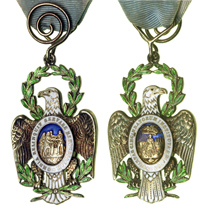 |
Society of the Cincinnati Eagle Insignia. Made by the Paris firm of Arthus Bertrand, c. early 1900s. Height 51 mm. Width 31 mm. Made of silver gilt. The head and tail are white enamel with gold lines; wreaths and sprigs are green enamel. The medallion obverse shows Cincinnatus receiving a sword from three senators; motto on white reads, "OMNIA RELINQUIT SERVARE REMPUBLICAM." (He abandons everything to serve his country). The reverse shows Cincinnatus at the plow; Fame is above and the sun in the distance. Motto on white reads, "SOCIETAS CINCINNATORUM INSTITUTA A.D.: 1783." The large badge is suspended from a small twisted loop; a spiral loop suspension, used from around 1900, holds a light blue and white ribbon for breast suspension. Ribbon shows wear, else Very Fine. The Society of the Cincinnati was organized near Newburgh, New York, on May 13, 1783 by Continental officers who fought in the American Revolution. George Washington was the first President General of the Society, from 1783 until his death in 1799.
Estimated Value $800 - 1,200.
View details and enlarged photo
| Realized
$4,888 |
Lot 31 |
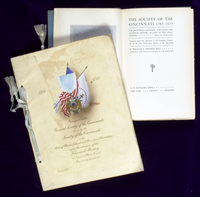 |
(Society of the Cincinnati). Two related items. No. 226 of a Limited Edition of 1000 signed copies of William Sturgis Thomas' The Society of the Cincinnati 1783-1935, published by G.P. Putnam's Sons, New York and London, 1935. 187 pages of information about the Society of the Cincinnati, from its inception in 1783 through 1935. Eight plates, with frontispiece of General George Washington. Cerrulean blue boards with small image of Eagle badge on cover; linen spine. Light wear to cover, else Fine.
Program for the "Banquet to the General Society of the Cincinnati given…in the State of Rhode Island and Providence Plantations upon the occasion of the Triennial Meeting…1911." 24 pages, large quarto, with engravings of personnages and events important in American history and to the Society of the Cincinnati, the first being of Cincinnatus and the second of George Washington. The engravings of Burgoyne's surrender at Saratoga and Cornwallis' surrender at Yorktown are in color. The cover and eight other pages have beautiful color embossings, including the American flag, the French flag, the American Army and Navy, the badge of the Society of the Cincinnati, the Continental Line of the Revolution, and more. Bound and tied with pale blue ribbon. Cover has a jagged two-inch tear at top edge and some soiling, but is otherwise Fine. Certainly rare and desirable. (2 items).
Estimated Value $600 - 800.
View details and enlarged photo
| Realized
$345 |
|
|